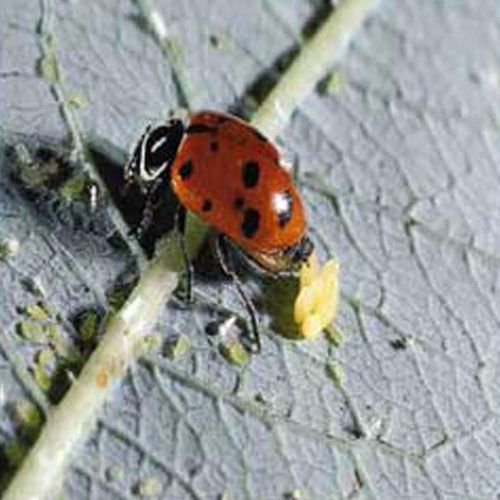When a Hornets Nest is Harmless
-
Helpful Products from Gardens Alive!
-
 Sta-Home™ Lady Beetles
Sta-Home™ Lady Beetles
Q. I enjoy your show and value your advice. I recently found a large nest in a bush in my back yard. The nest is about twelve inches in diameter but I didn't see anything come out of it. Can you tell me what animal, bird or insect built this nest and if I should be concerned? I have two small boys and I want to make sure they are safe.
---Joe in Horsham, PA
A. The picture Joe attached shows a notoriously famous shape; one that many of us recognize from seeing Elmer Fudd make poor decisions regarding them in old Warner Brothers' cartoons. Yes; a hornet's nest.
Specifically the nest of the bald-faced hornet; it's kind of a grayish-blue in color and shaped so much like a football you have to wonder if early football players didn't say, "hey—that pigskin is shaped just like a hornet's nest!" (Actually, I think their nest looks more like a hot air balloon than a football.)
At any rate, there's no danger to Joe or his boys from this thing now (January in PA) because it's empty—just like the similarly designed but underground nests that yellowjacket colonies used over the summer.
Both species of hornet/wasps behave the same: At the end of the season, newly-minted queens take flight just as the workers left behind begin dying off. Those queens will overwinter in protected areas and each one that survives will start the process of building a new nest—somewhere else—next Spring.
As with yellowjackets, the old hornet nest won't be re-used. These kinds of insects are 100% into new construction. Each new queen will choose a site, get the process started and then lay eggs that will produce workers, who will then chew up little bits of wood and bark, add the natural cement of their saliva, and eventually form a waterproof cone big enough to hold several hundred hornets—generally hanging from the branch of a tree.
But clearly not always hanging, as this nest was found inside the branches of some kind of shrub.
They can even appear on the outside of a home, which happened to us one year. We have a little balcony off of our bedroom and the hornets made a big nest up in the top of the inverted V of the roof outside, where the soffits probably provided a lot of protection from rain.
What did we do? The same thing you should—we just let it be. Yes, they freaked out my poor wife quite a bit, but we have a cathedral ceiling in the bedroom and the nest was in the outside peak of that ceiling, which meant it was a good ten feet over our heads when we were outside…
…And I was fairly certain that they weren't going to mess with us unless we approached their nest, which was about 16 feet above the walking area of our balcony, which itself was another ten feet or so off the ground—and I had no desire to try and portray Elmer Fudd on an extension ladder in that picture, so I convinced her to just try and ignore them.
You almost forget they're there after a month or so goes by and the only thing that happens is you see them coming and going out of the hole on the bottom of their nest. So we didn't look up a lot—or go out during windstorms. Meanwhile, our carnivorous houseguests were eating a ton of pest caterpillars and flies for us, and even doing a little pollination here and there. They're highly beneficial.
Now don't get me wrong—I do not tolerate yellowjacket nests on my property. I vacuum those dangerous insects out of the ground as soon as I find their nest because they're IN the ground (where avoidance is close to impossible) and these insects are hyper-aggressive when you get near their nest. Heck—yellowjackets are hyper-aggressive all the time. But the danger from bald faced hornets is clearly much less. This guy and his family never even noticed the nest in their shrub, and people probably walked very close to it without being stung, or even chased away.
And a hornet's nest appearing near a doorway or someplace else potentially dangerous to passersby is not that common a problem. These creatures don't want to build a nest where there's a lot of noise and activity. But if a nest does appear nearby and you really can't handle the potential danger, a professional in a protective bee suit can soak the nest with an oil spray on a cool night when they're sluggish and then bag it up or toss it into the woods.
And I specifically mean an oil spray. Although virtually every article on nest removal I found said to use toxic insecticides, there's zero need for poisons. Oil sprays smother the insects and kill them just fine.
But again, the ideal response is to just leave the nest alone. After winter has been in place for a couple of weeks, you can take the empty nest down if you like. Then give it to a teacher to cut in half in class so the students can examine the incredibly intricate building job these insects accomplish in such a short time. It really is one of the miracles of nature.
…Just be sure to wait until freezing cold has killed off all the hornets.-
Helpful Products from Gardens Alive!
-
 Sta-Home™ Lady Beetles
Sta-Home™ Lady Beetles







 Gardens Alive! & Supplies
Gardens Alive! & Supplies




